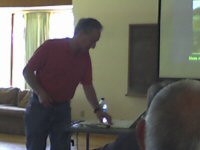Main Menu
Welcome
There are several molecular mechanisms involved in synaptic depression, e.g. depletion of the readily releasable vesicle pool (presynaptic) and receptor de-sensitization (postsynaptic).
The homosynaptic depression Tom studies is initiated by calcium but is independent of transmitter release. It involves suppression of vesicle fusion for periods up to 90 minutes.
This homosynaptic depression is somewhat reduced if the events triggering the synaptic transmission are not single spikes but bursts of spikes (burst protection). Burst protection is less effective in restoring transmission than it is in preventing depression in the first place. Maybe the burst protection exists in order to prevent habituation to important stimuli (getting back to the attention theme of the talk)? And indeed, activation of sensory neurons with bursts of stimuli to the skin protects against behavioral habituation. Now, is this non-associative learning or some primitive form of attention?
Tom went on to tell us a bit about the molecular pathways involved in burst protection. Calcium and PKC appear to be critically involved. He also showed that burst protection is highly frequency dependent. They used a modeling approach to address the question of how PKC distinguishes between bursts of different frequencies. It turned out that it is the number of calcium-binding sites on PKC which conveys the frequency-dependence of PKC action in burst protection.

Posted on Friday 08 June 2007 - 23:26:33 comment: 0
{TAGS}
{TAGS}
You must be logged in to make comments on this site - please log in, or if you are not registered click here to signup
Render time: 0.0577 sec, 0.0052 of that for queries.





